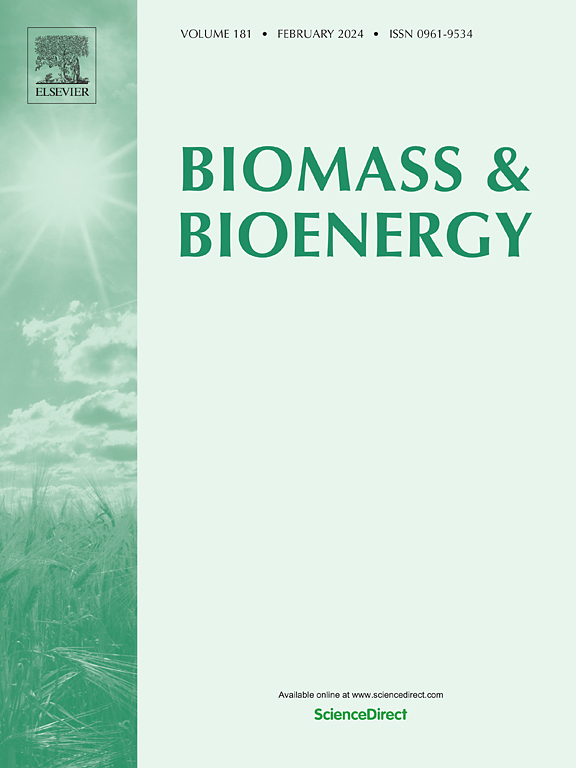利用不同酵母菌株从农业残留物中同时生产生物乙醇和挥发性化合物的可持续方法
IF 5.8
2区 生物学
Q1 AGRICULTURAL ENGINEERING
引用次数: 0
摘要
本研究通过优化的热化学预处理和发酵,探索了农业残留物,特别是稻草和混合蔬菜,在生物乙醇和挥发性化合物生产中的价值。采用Box-Behnken设计(BBD)对酸预处理和碱预处理进行了优化,酸预处理的稻草和混合蔬菜废弃物中纤维素含量分别提高了1.5倍和1.9倍,同时部分去除了半纤维素和木质素。FTIR分析证实,结构修饰和酶水解提高了糖的产量,酸预处理的混合蔬菜的生物量为495.71 mg/g。用4种酵母菌发酵产生乙醇,其中kmno4预处理的稻秆用苦皮草(Pitchia kudriavzevii) TISTR 5147产乙醇23.6 g/L,混合蔬菜用酿酒酵母(Saccharomyces cerevisiae) TISTR 5606产乙醇21.6 g/L。挥发性化合物分析鉴定出苯基乙醇和乙酸乙酯等富香味化合物,其中马氏克卢维菌TISTR 5616挥发性丰度最高。优化了发酵温度(30-36℃)、含氮量(5-15 g/L)、摇速(100-200 rpm)等参数,以提高挥发性化合物的产量。本研究强调了农业废弃物用于生物乙醇和芳香化合物生产的潜力,提出了具有工业应用的可持续生物炼制方法。本文章由计算机程序翻译,如有差异,请以英文原文为准。

A sustainable approach for the concurrent production of bioethanol and volatile compounds from agro residues using different yeast strains
This study explores the valorization of agricultural residues, specifically rice straw and mixed vegetables, for bioethanol and volatile compound production through optimized thermo-chemical pretreatment and fermentation. Acid and alkaline pretreatments were optimized using the Box–Behnken design (BBD), enhancing cellulose content by 1.5- and 1.9-fold in acid-pretreated rice straw and mixed vegetable wastes, respectively, while partially removing hemicellulose and lignin. FTIR analysis confirmed structural modifications and enzymatic hydrolysis improved sugar yields, with acid-pretreated mixed vegetables yielding 495.71 mg/g biomass. Fermentation with four yeast strains resulted in ethanol production, with KMnO4-pretreated rice straw yielding 23.6 g/L ethanol with Pitchia kudriavzevii TISTR 5147 and mixed vegetables yielding 21.6 g/L ethanol with Saccharomyces cerevisiae TISTR 5606. Volatile compound profiling identified aroma-rich compounds such as phenyl ethanol and ethyl acetate, with Kluyveromyces marxianus TISTR 5616 producing the highest volatile abundance. Fermentation parameters, including temperature (30–36 °C), nitrogen content (5–15 g/L), and shaking speed (100–200 rpm), were optimized for improved volatile compound production. This study highlights the potential of agricultural waste for bioethanol and aroma compound production, presenting a sustainable biorefinery approach with industrial applications.
求助全文
通过发布文献求助,成功后即可免费获取论文全文。
去求助
来源期刊

Biomass & Bioenergy
工程技术-能源与燃料
CiteScore
11.50
自引率
3.30%
发文量
258
审稿时长
60 days
期刊介绍:
Biomass & Bioenergy is an international journal publishing original research papers and short communications, review articles and case studies on biological resources, chemical and biological processes, and biomass products for new renewable sources of energy and materials.
The scope of the journal extends to the environmental, management and economic aspects of biomass and bioenergy.
Key areas covered by the journal:
• Biomass: sources, energy crop production processes, genetic improvements, composition. Please note that research on these biomass subjects must be linked directly to bioenergy generation.
• Biological Residues: residues/rests from agricultural production, forestry and plantations (palm, sugar etc), processing industries, and municipal sources (MSW). Papers on the use of biomass residues through innovative processes/technological novelty and/or consideration of feedstock/system sustainability (or unsustainability) are welcomed. However waste treatment processes and pollution control or mitigation which are only tangentially related to bioenergy are not in the scope of the journal, as they are more suited to publications in the environmental arena. Papers that describe conventional waste streams (ie well described in existing literature) that do not empirically address ''new'' added value from the process are not suitable for submission to the journal.
• Bioenergy Processes: fermentations, thermochemical conversions, liquid and gaseous fuels, and petrochemical substitutes
• Bioenergy Utilization: direct combustion, gasification, electricity production, chemical processes, and by-product remediation
• Biomass and the Environment: carbon cycle, the net energy efficiency of bioenergy systems, assessment of sustainability, and biodiversity issues.
 求助内容:
求助内容: 应助结果提醒方式:
应助结果提醒方式:


